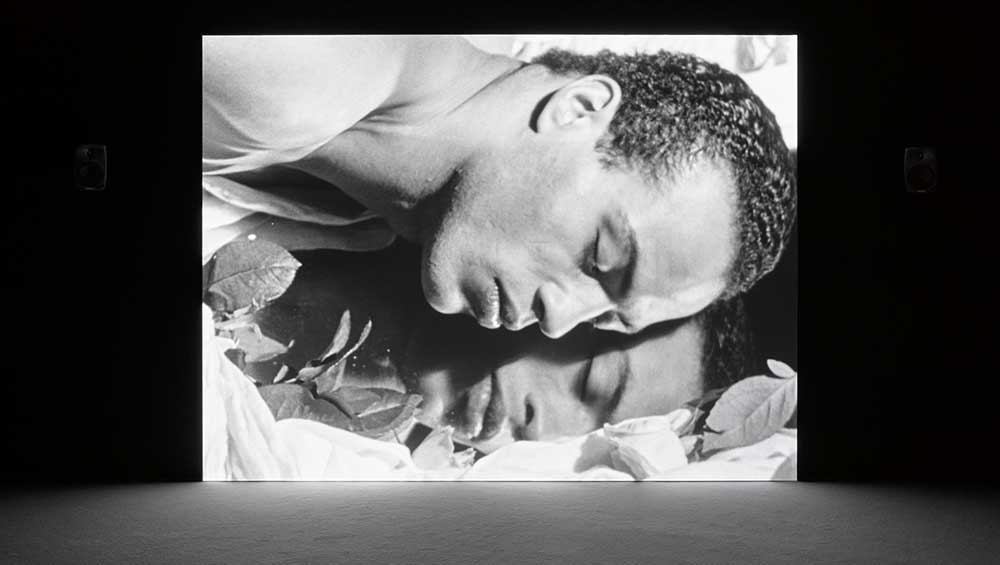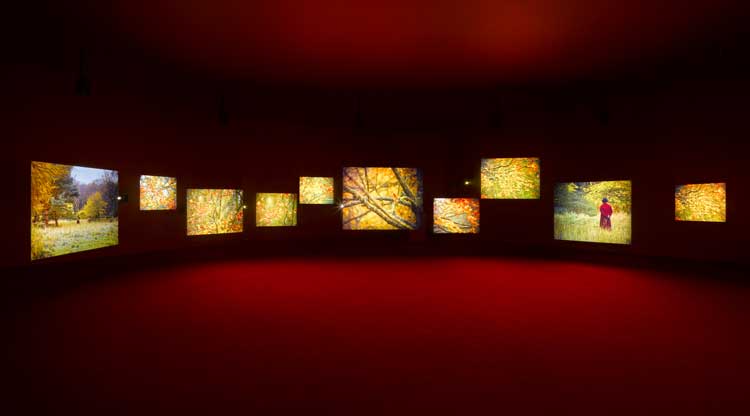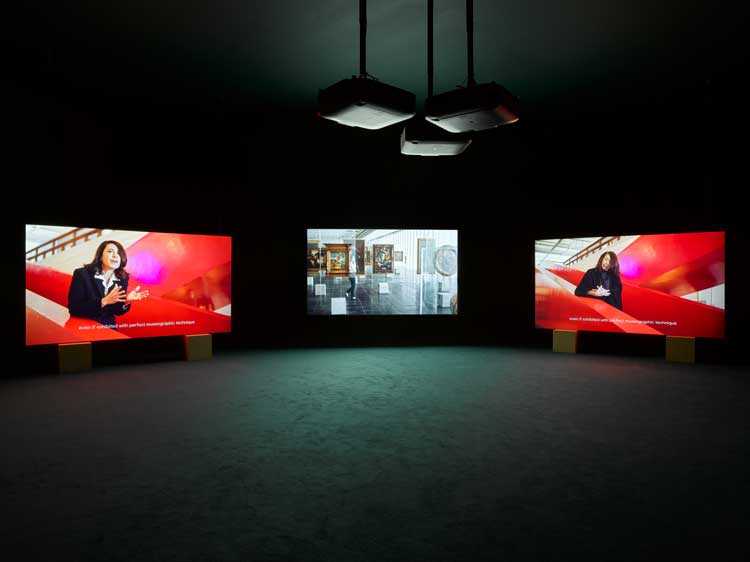
Isaac Julien, Looking for Langston, installation view, Tate Britain, 2023. Photo: Jack Hems. © Isaac Julien. Courtesy the artist and Victoria Miro.
Tate Britain, London
26 April – 20 August 2023
by BETH WILLIAMSON
Isaac Julien’s first survey exhibition in the UK is a tour de force. Charting the artist’s work over four decades from the 1980s until now, What Freedom Is to Me peels back the layers of Julien’s film-making to reveal a ferociously experimental and political career. What we see here is a series of key works that exemplify the artist’s practice as well as showcasing how he draws on other artistic disciplines such as film, dance, photography, music, theatre, painting and sculpture, from early films and videos made as part of Sankofa Film and Video Collective, to his sculptural, multiscreen installations that really steal the show.
-2019-(c)-Isaac-Julien.jpg)
Isaac Julien. The Lady of the Lake (Lessons of the Hour), 2019. Framed photograph on gloss inkjet paper mounted on aluminium, framed: 160 x 213.3 cm (63 x 84 in). © Isaac Julien.
Courtesy the artist and Victoria Miro.
As Julien explains it: “This gradual increase in scale – from one to two, to three, to five [screens], and so on – has always been in service to ideas and theories: film as sculpture, film and architecture, the dissonance between images, movement, and the mobile spectator.” And therein lies the power of these filmic installations, situated as they are around a particular gallery space, images shifting across screens and all the while spectators moving around the space. The mobile spectator, to use Julien’s own term, is active, engaged and entirely in control of their own journey and experience as they travel though a fluid exhibition space designed by the artist with the architect David Adjaye.
Julien doesn’t just make films, he intervenes in the museum: “Radically and aesthetically, I want to aim for an experience that can offer a novel way to see moving images, in its choice of subject, in how it’s displayed, in how it’s been shot … in every aspect.” When it works well, the spectator feels part of that intervention, empowered, emboldened, and hopeful for the possibilities that arise from Julien’s works.
.jpg)
Isaac Julien, Once Again…(Statues Never Die), installation view, Tate Britain, 2023. Photo: Jack Hems. © Isaac Julien. Courtesy the artist and Victoria Miro.
Entering the exhibition, we are immediately immersed in a multiscreen installation, complete with mirrors, statues and a pervading sense of something deeply wrong. This is Once Again … (Statues Never Die) (2022), which focuses on a conversation between Alain Locke, philosopher, educator and cultural theorist of the Harlem Renaissance, and Albert C Barnes, an early US collector and exhibitor of African material culture. Making direct reference to Julien’s film Looking for Langston (1989), it also gestures to contemporary debates around restitution in the museum. There is an overall sense of reflection and awakening in this work.
-2010-(c)-Isaac-Julien.jpg)
Isaac Julien, Mazu, Silence (Ten Thousand Waves), 2010. Endura Ultra photograph, 180 x 239.8 x 7.5 cm (70 7/8 x 94 3/8 x 3 in). © Isaac Julien. Courtesy the artist and Victoria Miro.
Western Union: Small Boats (2007) and Ten Thousand Waves (2010) together explore the movement of people across borders, countries and continents. Immigration policies in the UK and mainland Europe are being perpetually revised with controversial schemes attracting widespread criticism. In Western Union: Small Boats, Julien turns his scrutiny on the dangerous journeys made by people across the Mediterranean to southern Europe and how that impacts on those people and how and where they live. Ten Thousand Waves was made in the wake of the 2004 Morecambe Bay tragedy when 23 Chinese people drowned while working as cockle pickers.

Isaac Julien, Looking for Langston, installation view, Tate Britain, 2023. Photo: Jack Hems. © Isaac Julien. Courtesy the artist and Victoria Miro.
Looking for Langston (1989) is the earliest work in this exhibition. Made at the height of the HIV epidemic, it celebrates black queer love and rejects the rhetoric of homophobia. Exposing inner dialogues and asking important questions, the film gained cult status through its exploration of the complexity of the queer gaze.

Isaac Julien, Lessons of the Hour, installation view, Tate Britain, 2023. Photo: Jack Hems. © Isaac Julien. Courtesy the artist and Victoria Miro.
The 10-screen installation of Lessons of the Hour (2019) creates a powerful presence in the gallery as Julien tells the story of Frederick Douglass, a visionary abolitionist. With strong images of chain gangs, slave ships and skyscrapers, there is no doubt about the message that contemporary business wealth is built on the back on slavery. Excerpts from Douglass’s most famous speeches, such as “Lessons of the Hour”, are delivered on screen to an assembled contemporary audience while the 10 screens mirror the structure of a 19th-century salon hang, giving further credence to the setting.

Isaac Julien, Lina Bo Bardi – A Marvellous Entanglement, installation view, Tate Britain, 2023. Photo: Jack Hems. © Isaac Julien. Courtesy the artist and Victoria Miro.
Lina Bo Bardi – A Marvellous Entanglement (2019) is an entirely captivating film that tells the story of the Italian-born Brazilian modernist architect with a narrative that unfolds across seven public buildings designed by Bo Bardi – four in Salvador (in the Bahia region of Brazil) and three in São Paulo. The grey concrete facades are echoed in the concrete-like blocks that support the screens in the gallery, bringing the architecture of the film into the space of the spectator. With Julien’s filmic eye, actors, dancers and musicians choreograph Bo Bardi’s architectural spaces, bringing her social, political and cultural views to the fore.
Vagabondia (2000), filmed in Sir John Soane’s Museum in London, is a fantasy space in which the gallery walls are covered in lush red fabric, echoing the interior of the museum. A fictional conservator tours its spaces at night, imagining the histories behind the objects in the collection. The artist explained: “I used Creole to vocalise the conservator’s thought, and the narration is spoken by my mother, Rosemary Julien … I was trying to explore a version of the repressed histories.”
Through techniques of doubling, folding and unfolding of the image, Julien gestures to these repressed histories and his efforts to expose them. The small space in which this film is screened is itself oppressive, gesturing to the claustrophobic ideas and practices that institutions have engaged in and artists such as Julien tirelessly work to upend. It is from this small space that spectators exit the exhibition, into the Duveen Gallery at the heart of Tate Britain, ready, Julien surely hopes, to look at the institution, its collection, its displays and its practices with a fresh and more questioning eye. This is cultural activism at its best.